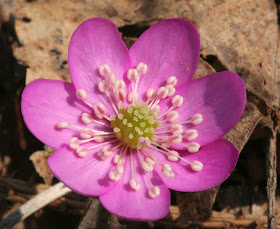Type of Flowers
Hepatica:
Hepatica is a herbaceous perennial growing from a rhizome in the buttercup family (Ranunculaceae), native to woodland in temperate regions of the Northern Hemisphere. Anemone hepatica grows 5–15 cm (2–6 in) high. Leaves and flowers emerge directly from the rhizome, not from a stem above ground. The leaves have three lobes and are fleshy and hairless, 7–9 cm (2.8–3.5 in) wide and 5–6 cm (2.0–2.4 in) long. The upper side is dark green with whitish stripes and the lower side is violet or reddish-brown. Leaves emerge during or after flowering and remain green through winter. The flowers are blue, purple, pink, or white and appear in winter or spring. They have five to ten oval showy sepals and three green bracts.
The hepatica is one of the first flowers to blossom in the spring, often preceding the vernal equinox that marks the beginning of the season. One would surmise this to be a survival strategy targeted at pollinators that would have no other source of nectar at that time of year; the hepatica would effectively monopolize the woodland market. However, hepaticas are self-pollinating, perfect flowers that have both male pollen and female ovaries; they have no need for external pollinators. This is just as well - there are few, if any, pollinators flitting about the mountains in winter. The beauty of the hepatica efflorescence has inspired paeans of praise. John Burroughs, the noted American Naturalist, wrote in his book “America” that there is “….nothing fairer, if as fair, the first flower, the hepatica. I find I have never admired this little firstling half enough when at the maturity of its charms, it is certainly the gem of the woods.”
The name hepatica was first given to the flower in the early 18th Century by the German botanist Johann Jacob Dillenius due to its liver shaped leaves (hepar is the Greek word for liver). Carolus Linnaeus, the father of botanical classification, included it in the genus Anemone (as A. hepatica) in the seminal “Species Plantarum” in 1753. Both plants are in Ranunculaceae, the Buttercup Family, so there is some rationale for this alternative assignation. Hepatica is sometimes listed generically as Anemone with a variety of species names, particularly in European references. The main point is that the hepatica was initially associated with the liver due to its appearance, a fact that led to protracted medicinal confusion that continues to the present.
The use of hepatica by Native Americans in conjunction with the historical use of it in the Old World for liver disorders gave the flower a somewhat different medicinal and cultural trajectory in the Americas. C. S. Rafinesque established hepatica as a significant medicinal herb as Plate 48 in the seminal 1828 “Medical Flora, or Manual of the Medical Botany of the United States of North America.” Describing it as “Scentless and nearly insipid, not bitter; but a little astringent and mucilaginous,” he ascribes a rather astounding range of conditions that hepatica has and should be used for:
“It was formerly used in fevers, liver complaints, indigestion, cachexy (general physical wasting), hypochondria and hernia. It has lately been brought to notice in America for hemoptysis and coughs; it has been used in Virginia with benefit in the form of a strong infusion, drunk cold. It may be serviceable in hepatitis and hepatic phthisis, as well as all complaints arising from dyspepsia and hypochondric affections; it may be used as a tea, warm or cold and adlibitum (‘as you would like to’ – i. e. for anything else); but it has no effect on the lungs beyond that of a mild demulcent astringent.”
www.sierrapotomac.org/W_Needham/Hepatica_120303.htm
www.flickr.com




















nice blogs with plenty of good content try some menetization of your blog..
ReplyDeletehttp://earningonline4you.blogspot.com
Thanks I am Trying but no success..
Delete